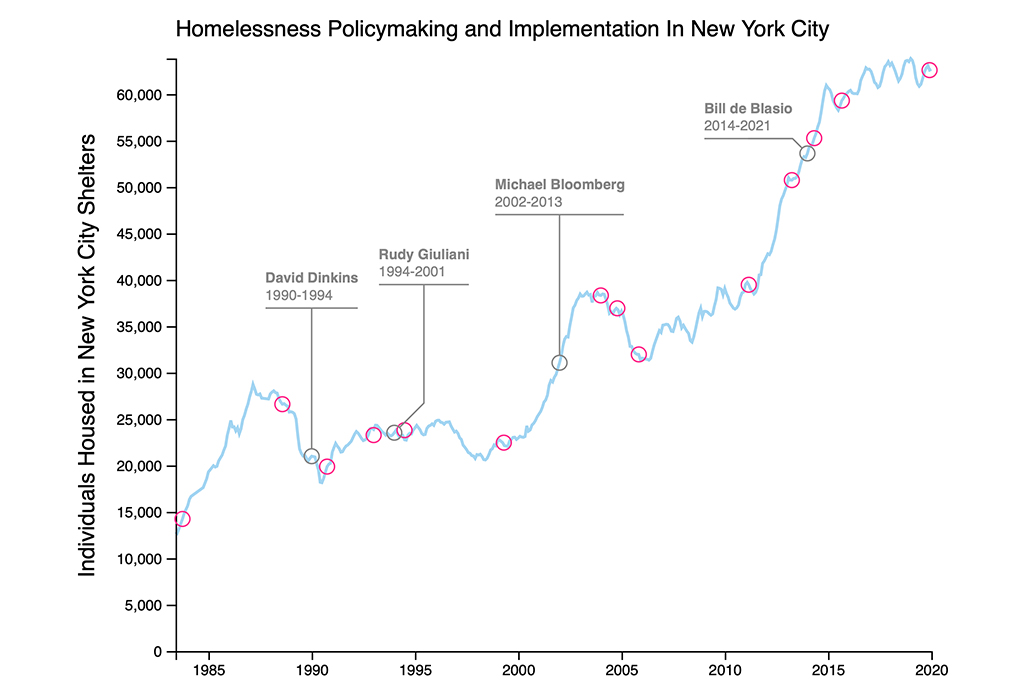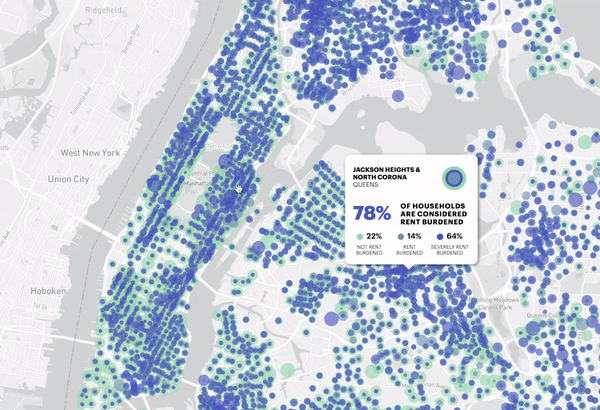Right to Housing
Can New York City’s housing crisis be fixed? It will take more than a turnover in key political players to ameliorate the problem, and budget cuts caused by the coronavirus crisis may hamper future efforts to improve the city’s housing stock or tackle its homelessness crisis.
One of Mayor Bill de Blasio’s signature policies, Housing New York34, promised to create or preserve 300,000 affordable apartments by 2026, an ambitious goal that the administration says it expects to meet. But many of those homes become available through the city’s affordable housing lottery, which has its own problems: affordability is determined by the area median income rather than the income of a neighborhood, leading to rents that can be wildly out of proportion with what residents are able to pay. There are also too few apartments, and too many applicants for those units; according to The New York Times, since 2013, 25 million people have applied for just 40,000 affordable apartments35.
Another source of affordable housing is the city’s nearly 1 million rent-stabilized apartments. Since 1993, hundreds of thousands of rent-stabilized units have disappeared as landlord-friendly laws made it easier to deregulate the apartments or implement minor repairs that would allow rent hikes to kick in. In recent years, both New York City and State have enacted legislation intended to stanch the loss of those units.
Landlords are now limited in the ways that they can remove an apartment from being rent-regulated, and tenants have more rights if they suspect that they’ve been taken advantage of. The city, meanwhile, unveiled the Office to Protect Tenants, which provides information for renters who face eviction or have issues with their landlords. The city’s Rent Guidelines Board, which implements increases on rent-stabilized apartments, also voted in 2020 to enact a rent freeze on one-year leases in response to the coronavirus crisis36.
Still, there are no easy answers, and the city’s fiscal woes have made things more dire. The NYC Department of Housing Preservation and Development, which is responsible for many of NYC’s affordable housing programs, had its FY2021 budget slashed because of the pandemic, putting some programs—such as one to create more affordable apartments out of basements and accessory dwelling units—in jeopardy37. Pushback on neighborhood rezonings, which typically lead to the creation of affordable apartments, has put the de Blasio administration’s house program in jeopardy38. The deterioration of NYCHA buildings will likely get worse without more funding sources, but many residents fear that privatization will lead to displacement39.
Residents of NYCHA complexes have also been especially hard hit by the coronavirus pandemic: as of May 2020, more than 1,200 residents had died from Covid-19, and more than 7,800 people had tested positive for the coronavirus40.
It’s clear that more needs to be done, and elected officials—both those in office now and those who will take office after the 2021 election—must be creative and proactive in finding solutions to the affordability crisis.
Where Is the Rent Burden?
This data visualization was created by the Civic Data Design Lab.
While most people agree that New York City needs more affordable housing, there is little consensus on what constitutes “affordable.”
Affordability can be measured in a number of ways. The NYC Department of Housing Preservation and Development uses the federally-defined Area Median Income (AMI) to determine who is eligible for city-subsidized affordable apartments. But that figure—$102,400 for a three-person family—is at odds with the actual median household income of New York City, which is closer to $60,000 (as of 2018). Median incomes also vary widely from neighborhood to neighborhood, leading to housing that may be far above what the average resident can afford.
We can also look at the cost of housing in New York City: according to a report from Comptroller Scott Stringer, median gross rents increased four percent year-over-year between 2005 and 2017, but wages did not keep pace41.
Another way to measure affordability is by looking at whether or not residents throughout the city are rent-burdened. “Rent burden” means that more than 30 percent of your annual income goes toward housing costs, and in New York City, 44 percent of households fit the bill, with 25 percent qualifying as severely rent-burdened.
Where do rent-burdened New Yorkers live? This visualization offers a look at that data. A 2019 report from the Association for Neighborhood and Housing Development42 found that the highest share of rent-burdened New Yorkers is concentrated in the Bronx. That corresponds to CDDL’s visualization, which shows that severely rent-burdened New Yorkers—those that dedicate more than 50 percent of their income on housing costs—also predominantly live in the Bronx.
These affordability issues existed before the coronavirus pandemic, and the ongoing health crisis is likely to exacerbate the problem. “The combination of severe rent burden, lost wages, and little to no emergency savings is likely to result in large-scale housing instability,” according to a 2020 report by NYU’s Furman Center43. As the pandemic goes on, the problem is likely to get worse, and may even contribute to the city’s homelessness crisis.
Tackling Homelessness
 Visit Project Tackling Homelessness at its Roots This student data visualization was created by Akshay Choudhary, Jingyi Liu, Sarah Littlefield at the Massachusetts Institute of Technology in the spring semester of 2020.
Visit Project Tackling Homelessness at its Roots This student data visualization was created by Akshay Choudhary, Jingyi Liu, Sarah Littlefield at the Massachusetts Institute of Technology in the spring semester of 2020.
Before the coronavirus pandemic, New York City was already struggling to fix its homelessness crisis.
Approximately 60,000 people sleep in homeless shelters each night, and thousands more find themselves on the streets. According to the nonprofit Coalition for the Homeless44, these figures represent the highest number of homeless New Yorkers since the Great Depression.
The crisis didn’t happen overnight; many different issues—systemic racism, domestic violence, a lack of resources for people with mental health issues, disinvestment from various levels of government, and shifting policies from various mayoral administrations—have contributed to the problem, according to an early 2020 City Council report45 on the crisis. And while Mayor Bill de Blasio’s administration has made efforts to stem the tide, it has inherited a problem of epic proportions—one that the Council’s report calls “an accepted reality that the City treats as a crisis to be managed.”
Then the coronavirus pandemic hit, further exacerbating the problems plaguing homeless New Yorkers. COVID-19 spread rapidly throughout the overcrowded shelter system, and the mortality rate for homeless New Yorkers who contracted the coronavirus was much higher than that of average New Yorkers46. The city committed to moving people from shelters into hotels with empty rooms, but the plan has been met with resistance from residents of those neighborhoods.
The COVID-19 crisis is poised to make the homelessness crisis worse, as more New Yorkers struggle to pay their rent and face the threat of eviction. Solutions such as creating or preserving more affordable housing that’s targeted at low- and very low-income New Yorkers, and building supportive housing that can help those with mental health or addiction issues, would go a long way toward solving the issue47.
Explore the student visualization to learn more about New York City’s homelessness crisis, including where residents are most likely to experience homelessness.
References
34. Housing New York https://www1.nyc.gov/assets/hpd/downloads/pdfs/about/housing-new-york-2-0.pdf
35. 25 Million Applications: The Scramble for N.Y.C. Affordable Housing, The New York Times https://www.nytimes.com/2020/06/15/nyregion/nyc-affordable-housing-lottery.html
36. Nearly 1 Million NYC Rent-Stabilized Apartments Get Rent Freeze, Curbed https://ny.curbed.com/2020/6/18/21294801/nyc-rent-guidelines-board-rent-freeze-coronavirus
37. Council Softens but Doesn’t Stop Hit to Housing Budget, City Limits https://citylimits.org/2020/07/01/council-softens-but-doesnt-stop-hit-to-housing-budget/
38. As NYC neighborhoods push back against rezonings, de Blasio’s signature housing policy is threatened, Curbed https://ny.curbed.com/2020/2/6/21123983/nyc-affordable-housing-rezoning-bill-de-blasio
39. Feeling Left Out, Public Housing Tenants ‘Not on Board’ With Privatization Plan, The City https://www.thecity.nyc/housing/2020/7/19/21330309/public-housing-tenants-nycha-privatization-manhattan-housing
40. These N.Y.C. Neighborhoods Have the Highest Rates of Virus Deaths, The New York Times https://www.nytimes.com/2020/05/18/nyregion/coronavirus-deaths-nyc.html
41. Affordability Index, New York City Comptroller https://comptroller.nyc.gov/reports/affordability-index/
42. How is Affordable Housing Threatened in your Neighborhood?, Association for Neighborhood & Housing Development https://anhd.org/sites/default/files/2019_risk_chart_final.pdf
43. New York’s Housing Insecurity By The Numbers, NYU Furman Center https://furmancenter.org/thestoop/entry/nyc-housing-insecurity-by-the-numbers
44. Basic Facts About Homelessness: New York City, Coalition for the Homeless https://www.coalitionforthehomeless.org/basic-facts-about-homelessness-new-york-city/#:~:text=The%20Basic%20Facts-,In%20recent%20years%2C%20homelessness%20in%20New%20York%20City%20has%20reached,York%20City%20municipal%20shelter%20system.
45. Our Homelessness Crisis: The Case for Change, New York City Council http://council.nyc.gov/data/wp-content/uploads/sites/73/2020/01/FINAL-PAPER.pdf
46. Covid-19 and Homelessness in NYC, Coalition for the Homeless https://coalitionforthehomeless.org/wp-content/uploads/2020/06/COVID19HomelessnessReportJune2020.pdf
47. Housing, rental vouchers, outreach: Can NYC fix its homeless crisis?, Curbed https://ny.curbed.com/2020/2/25/21146143/homelessness-new-york-city-how-to-fix
Additional Resources
See more +
See less –














